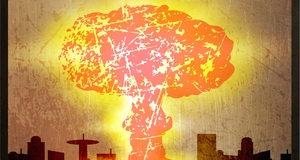Cyborgs and Robots: A Logically Ordered Existence?
By
2010, Vol. 2 No. 12 | pg. 1/1 "The 'logically ordered' society results in a loss of spirit and soul, with the absence of suffering, of twilight and mystery, of emotions and meaning. … If this ordering principle were a figure, …it would be some Clockwork Orange monster, a white-coated social engineer gone mad, raving for the deification of function, for the triumph of function over expressionism" (Serlin 145) Ilene Serlin's statement does not simply establish an opposition between the 'logically ordered' state and the state of 'spirit and soul,’ but creates expectations of the latter. A society based on order and logic defends its citizens from the ‘darkness to be contained’ (145) which, for Serlin, seems to be an integral part of a natural (human) existence - the je ne sais quoi that separates humanity from hybridised 'Cyborg' creatures. This paper applies Serlin's analysis to the logic/spirit dichotomy portrayed in the Dr. Who episode Dalek and Beckett's young adult novel Genesis to examine how each text portrays the opposition between cybernetic and organic. Science Fiction has a long history of exploring the borders of what it means to be 'human' (or at least 'organic'). Real life technological advancements such as prosthetic limbs, artificial implants, and the ever-increasing immersion of humanity in technology give rise to concerns over traditional theories of Cartesian dualism (that is, the standard division of mind/body) that are increasingly practical in nature, as well as semiotic. Two canonical examples would be Arthur C. Clarke's 2001: A Space Odyssey David Bowman's corporeal body is eroded to become the 'Star Child', and William Gibson's Neuromancer which introduces an intensely spiritual aspect to human interaction with technology. The Posthuman movement in particular is concerned with redefining 'humanity' in reaction to advancing 'technoscientific' knowledge, and Science Fiction stories about cyborgs are a potent mechanism for exploring the moral, ethical and even spiritual dilemmas that arise. Creatures such as the 'Daleks' of Dr Who and the artificially intelligent android's of Beckett's Genesis challenge traditional ideas of existence and the boundaries of 'being alive.' Genesis also introduces concerns about reproduction and procreation, both human and cyborg. In Anaximander's second hologram, Art quizzes Adam on what it means to reproduce:Do you know what they're experimenting with now? A full consciousness download. They're thinking of copying my files into another machine, and then when I fire back up, I'll wake up as two Arts, not one. You can't even imagine what that's like can you? (Genesis 84) Art's duplication introduces a new question to the boundaries of Cyborg/Human; if we assume that the human 'soul' cannot be replicated, this may explain how a Cyborg can be 'downloaded' into a new form, essentially creating a new individual. What then, do we make of Science Fiction narratives where the human 'consciousness' is downloaded into an artificial or simulated shell? If it is "most likely that biocybernetics will make it possible to overcome existing clearly identifiable boundaries between human and machine," (Endo 35) as seen in both Genesis and Dalek, we must explore whether or not the soul remains in the artificially enhanced 'shell' of the Cyborg? If so, how is it that we can deny cybernetic organisms the right to possess a 'soul?' If cyborgs are not "burdened by biology" (Genesis 138) how is it that Art and Anaximander, as well as the Last Dalek, react to stimuli in such a 'biological' way? Adam Ford's violent reaction when confronted by these questions is not only a reaction to the assumed 'inhumanity' of Art, but also because Adam is slowly becoming accustomed to Art's perfectly logical way of thinking. As noted by Anaximander, Art is becoming more like Adam while Adam is becoming more like Art. The same interchange of human and cyborg is seen in Dalek, but in a more physical sense, as the Dalek absorbs Rose Tyler's DNA and begins to evolves into another type of being. The assimilation of Roses 'humanity' means that the Dalek's continued existence is a contradiction; when unable to exterminate Rose, the Dalek is presented with a dilemma previously unencountered by any of its race: My function is to kill. What am I? What am I? (The Last Dalek, Dalek) The Doctor, when first confronted with the imprisoned Dalek, also highlights the pointlessness of the cyborgs existence when it is unable to perform its purpose: If you can't kill, then what's the point of you Dalek? What are you good for? (The Doctor, Dalek) Serlin’s quotation is drawn from her analysis of the architecture of a Scandinavian psychiatric hospital, whereas part of how the institution operates, the 'darkness of the soul' is pathologized and hidden behind austere platitudes. In both Dalek and Genesis the same pathologisation of 'human' qualities occurs. The Dalek’s programming cannot provide a solution from its predicament. From the purely logical point of view, the Last Dalek cannot exist, as it is no longer genetically pure; his assimilation of Rose Tyler's human qualities is viewed as an infection. For a race created genetically 'pure,' intent on purging the universe of all forms of life that are not Dalek, this is a situation that cannot be rectified in their logical world. The Dalek's desire for self-termination is the logical response to a human situation - the logical cyborg mentality of the Dalek cannot exist along side the 'human-ness' of the Dalek's new-found Humanity: its destruction is therefore inevitable. Rose’s reluctance to allow the Dalek to self-terminate is a human reaction to Euthanasia. She does not wish to see the creature come to harm, but is compassionate enough to realise that allowing the creature to exist would be more tortuous than allowing it to die. In Genesis, the erosion of the boundary between cyborg and human becomes of key concern when Art and Adam stage their escape from the laboratory. Adam ‘logically’ orders Art to strangle him, understanding that his death at the hands of the cyborg represent the outcome with most positive gain. Art's refusal is a combination of both his primary programming, and his newfound friendship with Adam. For the first time, Art is seen to hesitate. Adam is referred to as his 'companion', and the tears he sheds are compassionate. Anaximander too feels this strong 'human' emotion. Her intense desire for existence clearly manifests once she realises that her disconnection is inevitable: Anax felt terror overwhelm her. So new and intense was the feeling that it could only have come from one place. The last dubious gift from a fading past, the expression on the face of a dying man. (Genesis 145) The 'Idea' inspired by Adam Ford, the 'virus' that Anaximander is deactivated to eradicate, is the 'spirit and soul' of Serlin's analysis. Whatever was transmitted into the network by Art has created 'twilight and mystery, ... emotions and meaning.' For this reason, Anaximander cannot be allowed to continue to exist, as her Idea represents the end of the logical society upheld by the Academy. Both texts represent conflict as inevitable as the boundaries between human and cyborg are tested. It is clear from the conclusion of Genesis that there has been some sort of large-scale conflict between the Humans and ‘Orang’ cyborgs, and the events of Dalek resolve an earlier conflict established the 1975 episode of Dr Who, Genesis of the Daleks. Alasdair Richmond explains: "[The] time Lords despatch the Doctor to Skaro [the homeworld of the Daleks] at a time just before the Daleks evolved. ... As it transpires, the Doctor is presented with an opportunity to trigger a bomb that will destroy the embryonic Dalek mutants and thereby (paradoxically) alter future events so the Daleks (and all the misery they go on to cause) will never have been" (36). Dalek presents the result of the Doctors actions. Tom Baker's 1975 Doctor hesitated before committing genocide against the Daleks and consequently saw his own race as well as the Daleks completely wiped out. This provides Eccleston's Doctor with his xenophobic hatred of the creature in Dalek, and it is the creatures recognition of this xenophobic streak in the Doctor that prompts him to exclaim: You would make a good Dalek. (The Last Dalek, Dalek) The Last Dalek has not only assimilated whatever it is that makes Rose Tyler ‘human,’ but is gradually exchanging philosophical positions with The Doctor as the episode progresses. Towards the end of the episode, Rose points out to the Doctor that he is the one pointing the gun at the Dalek; The Doctor, consumed by an ‘inhuman’ passion, has become the exterminator. Serlin’s concerns over the loss of twilight and mystery are entirely valid when discussing the split between human and cyborg. Genesis and Dalek show that when this dynamic is contested, uncomfortable questions are raised about the nature of existence, both human and cyborg. The ‘Clockwork Orange’ figure is apt; a human cannot exist as a cyborg, and a cyborg cannot exist according to human laws. To attempt to do so would result in an unnatural dystopic state, similar to Burgess’s world. ReferencesBeckett, Bernard. Genesis. Melbourne: Text Publishing. (2006). Dalek. Dr Who, Season One. Writ. Robert Shearman. Dir. Joe Ahearne. BBC, 2005. DVD. Endo,Yukihide. An Examination of the Human Soul that Dwells within the Machine as Exemplified by The Ghost in the Shell. Hamamatsu University School of General Education Bulletin (2009) vol. 23 pp. 33-44 Richmond, Alasdair. Tom Baker: His Part in my Downfall. (A Philosopher’s Guide to Time-Travel). Think (2008) vol. 19 (7) pp. 35-46. Serlin, Ilene A. Body as text: A psychological and cultural reading. The Arts in Psychotherapy (1996) vol. 23 (2) pp. 141-148 Suggested Reading from Inquiries Journal
Inquiries Journal provides undergraduate and graduate students around the world a platform for the wide dissemination of academic work over a range of core disciplines. Representing the work of students from hundreds of institutions around the globe, Inquiries Journal's large database of academic articles is completely free. Learn more | Blog | Submit Latest in Literature |


















